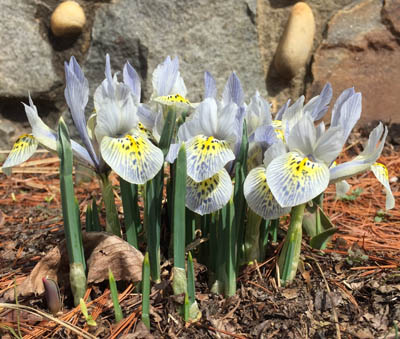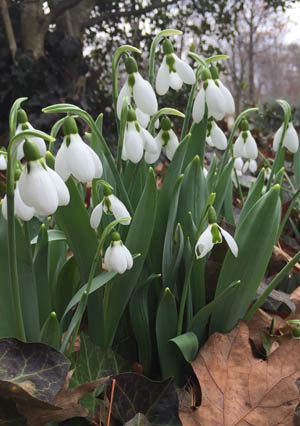A Winter Day in the Life of a Master Gardener
By Doug Coffey, Fairfax Master Gardener Intern

Acer japonicum
6:30 am
Looked out the windows to see if it snowed last night. Checked the weather channel for rain predictions for the next seven days. None expected but maybe a chance of snow, 1 to 4 inches, which everyone knows is equivalent to only about a ¼ inch of rain.
8:30 am
Monitored house plants. New plants received during the holidays may bring in unwanted guests, such as aphids, spider mites and white flies that could infect the other house plants. Sprayed plants with a little insecticidal soap or horticultural oil like neem oil. Checked potting soil and tried to remember when they were last watered. Cleaned up fallen leaves and worried about whether the light, temperature and water are within the proper range.
10:30 am
Multi-tasked by walking the dog around the yard while checking the weather’s impact on shrubbery and the flower garden. Abruptly ended dog walk after noticing evidence of two pests in the iris garden, voles and apparently Canada geese!!

Iris reticulata
Urgent research needed to get to the bottom of these pests. Discovered that voles (Microtus pennsylvanicus) don’t hibernate, have a range of about 3/4 acre, the size of my iris garden, and they are snacking on the rhizomes, leaving nothing but the leaf fans. These little critters are some of the most prolific breeders in the rodent family, 5 to 10 litters per year with 3 to 6 young per litter, and they reproduce year-round. Quick calculations based on 50 percent female births and maturity: I’ll have a 5,000- vole invasion in one year. YIKES!!. And on top of that, now a gaggle of Canada geese (Branta canadensis) have nibbled down the tops of the iris to an inch or so above the rhizome. Am I going to have anything left by Spring? Turns out chances are still good.

snow drops, Galanthus nivalis
Resumed yard walk around. Observed that rhododendrons look really droopy but they will bounce back when temperatures are above freezing. Daffodils (Narcissus) and other early blooming flowers such as snow drops (Galanthus nivalis) are already starting to break the surface. Noticed that the red maple tree (Acer rubrum) leaf buds are already starting to fatten up. After a week of temperatures in the teens, reread Chapter 7 of Master Gardener’s Handbook, A Guide to Gardening in Virginia. Reminded myself of the difference between chilling and freezing stress.
12:30 pm
Planned and designed a raised vegetable garden. Considered fencing options to keep out deer and rabbits. Perhaps a heavy-duty nylon netting about 8 feet tall with a chicken wire base that goes below ground to keep out moles and rabbits. Laid out a grid of 4×8 foot gardening beds for ease of tending. Plan this year includes an expanded herb garden to include: basil (Ocimum basilicum), cilantro (Coriandrum sativum), chives (Allium schoenoprasum), dill, (Anethum graveolens), lemongrass (Cymbopogon citratus), oregano (Origanum hirtum), marjoram (Origanum majorana), rosemary (Rosmarinus officinalis), thyme (Thymus vulgaris), parsley (Petroselinum crispum), sage (Salvia officinalis), and summer savory (Satureja hortensis).

Acer rubrum
Resumed walking the dog to the mailbox. Made a mental note about damaged trees that need to be trimmed or removed.
1:45 pm
Spent a couple of hours looking at the new seed catalogs from John Scheepers Kitchen Garden Seeds that carry heirloom seeds, Select Seeds for native and pollinator flowers, and Southern Exposure Seed Exchange, a catalog from a co-op near Richmond that avoids chemically treated seeds and offers over 700 varieties of heirloom vegetable, flower, herb, grain and cover crop seeds ideally suited for Mid-Atlantic gardeners. So many options. It’s going to be a great vegetable and flower garden this year. Hmmm.
3:45 pm
Revised layout of vegetable garden since I’ve picked out more seeds than I’ve allowed space for.
4:30 pm
Have been feeling guilty about throwing away potato peels, and vegetable scraps. I need a vermiculture box to start organic composting. Researched and read how to build a “worm bin.” Learned that a red worm (Eisenia fetida) works best.
Learned that an advantage of “worm bins” over traditional composting is that if the bin is inside during the winter, the process can work all year. Using earthworms to convert organic wastes is an ecologically safe method that leads to an environmentally safe product.
7:30 pm
Spent an hour with a relaxing read from one of the new books in my gardening library, The Roots of My Obsession, essays from 30 gardeners about why they garden.
“Just being in a garden gives me incredible peace, like being in a …cathedral on a hot afternoon, when there’s nobody around, only the sun beaming from high above, lighting up motes of dust. Somewhere I can gather all my thoughts and deal with them, slowly and quietly, one at a time.”
~ Helen Dillon, “There Lies Peace” an essay from The Roots of My Obsession
Then my mind wandered to voles, wondering how many of those varmints were added to the population today. Maybe time would be better spent getting ideas from other gardens. Perused a coffee table book on the best gardens of the world, The Gardener’s Garden, 450 pages of color photos of most significant gardens from around the world to stimulate and inspire. Added Chanticleer, Wayne, PA and Dumbarton Oaks, Washington DC to my bucket list of gardens to visit in 2018. Other featured gardens are within a day’s drive of Northern Virginia:
Longwood Gardens, Kennett Square PA
Colonial Williamsburg, Williamsburg, VA
Mount Vernon, Mount Vernon, VA
Monticello, Charlottesville, VA
Winterthur, Wilmington, DE
Bedtime Meditation
John 15:5: I am the vine; you are the branches. If you remain in me and I in you, you will bear much fruit; apart from me you can do nothing.
References
Worm Composting Basics, Jen Fong and Paula Hewitt,Cornell University
Roots of My Obsession, Edited by Thomas Cooper
Gardener’s Garden, Edited by Toby Musgrave